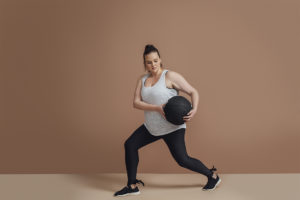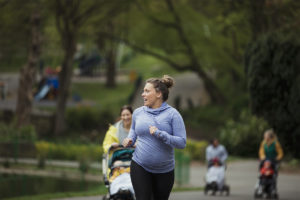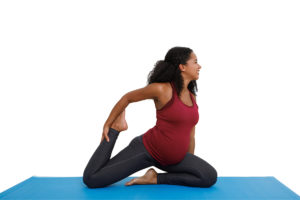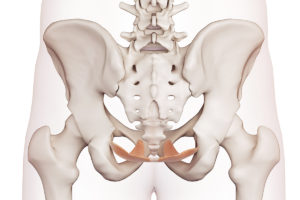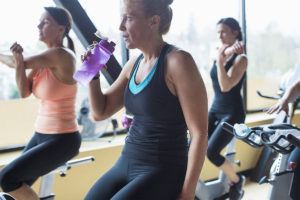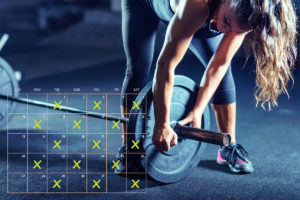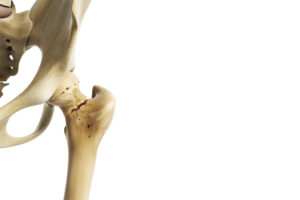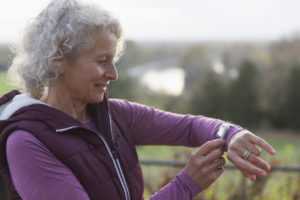HIIT Neuromuscular Training Helps Inactive Women
To stimulate inactive or overweight clients’ programming, try blending high-intensity interval training and functional resistance training.
Pregnant Exercisers Can Improve Aerobic Fitness
Prenatal exercise can be a beneficial and effective way to increase maternal cardiorespiratory fitness, even for inactive women.
Stay Active During Perimenopause
You can motivate female clients to value training during the perimenopausal years for the dividends it pays in stoking metabolism.
Why Men Breathe More Easily Than Women When Exercising
Women, on average, have a more difficult time breathing during vigorous exercise because their airways are smaller, according to The FASEB Journal.
A Pregnant Pause
Desi Bartlett, MS, CPT, E-RYT, met Natiya Guin at her yoga class and later guided her training through her second pregnancy.
Prenatal Yoga Practice May Ease Delivery
Here’s more insight into how yoga helps pregnant exercise enthusiasts. Yoga may also play a role in shortening the first and second stages of labor.
Exercise and Mental Fitness
Researchers analyzed 80 studies on physical training’s cognitive benefits, highlighting differences by activity, gender and intensity.
Moms-to-Be Can Still Go Fish
Findings published in JAMA Network Open should help expectant mothers to rest a bit easier the next time they troll for dinner at the fishmonger.
Prenatal Exercise Promotes Healthy Circulation
New research findings suggest that prenatal exercise may lower a woman’s risk of developing high blood pressure when pregnant.
Pelvic-Floor Exercise Training and Prenatal Exercise Programs
Polish researchers evaluated the effects of adding pelvic-floor muscle education and training to a prenatal high-/low-impact exercise program.
Exercise and Longevity for Women
A new study further supports the benefits of maintaining cardiovascular fitness during middle-age and beyond. In a study presented at the European Society of Cardiology’s EuroEcho 2019 meeting in Vienna, high cardiovascular fitness was linked with significantly lower death risks from heart disease, cancer and other causes for middle-aged and older women.
Women and Strength Training
Women do not respond to weight training the same way men do. University of New South Wales researchers in Sydney conducted a comprehensive search of the literature on resistance training and found only 24 randomized controlled studies that focused exclusively on women. Lead study author Amanda “Mandy” D. Hagstrom, PhD, lecturer in exercise science at UNSW Medicine, said, “I was surprised. I knew there wouldn’t be many [studies], but I thought there’d be more than that.” The selected studies included almost 1,000 women.
Training Loads for Women Over 40
Personal trainers often have female clients over the age of 40 who have similar complaints about losing muscle mass and gaining body fat. Although these changes aren’t unexpected and can be a normal part of the aging process, they are not inevitable. In fact, the right resistance-training program can positively affect body composition by reducing fat, maintaining and building muscle, and increasing strength in this population.
Hip Fracture Risks and Postmenopausal Women
Hip fractures have serious consequences, including an increased risk of death within the first year following the accident. Findings from a recent study offer good news on the benefits of physical activity for postmenopausal women.
Vigorous Exercise Is Safe for Most Expectant Mothers
Good news for pregnant exercise enthusiasts: Vigorous exercise, even in the third trimester, is safe for healthy pregnant women, according to a study reported in BMC Pregnancy and Childbirth (2019; 19 [1], 281).
Many Female Athletes Need to Eat More
For the most part, sports nutrition science is bro-science. That’s because the vast majority of studies to date have focused on men, leaving active women to assume the same results apply to them. But that is slowly changing.
Are 10,000 Steps Necessary?
Are some of your clients obsessed with achieving their step counts every day? While 10,000 steps is a popular marker, it turns out that taking as few as 4,400 steps per day is associated with a lower risk of death for women with a mean age of 72 years.
“Clearly, even a modest number of steps was related to lower mortality rate among these older women,” said principal investigator I-Min Lee, MBBS ScD, at Brigham and Women’s Hospital in Boston.
Maternal Weight and Pregnancy Complications
Encourage your pregnant clients (if cleared by their doctors) to keep working out with you. A new study shows that maintaining a healthy weight before and during pregnancy is a key factor in avoiding pregnancy complications.
Caffeine—An Equal Opportunity Ergogenic Aid
Caffeine is known to increase performance when taken before endurance activities, but more than 80% of studies have focused on men. A recent randomized, double-blind, crossover study out of Queensland, Australia, aimed to determine whether or not gender affects ergogenic responses to caffeine.
Switching to Poultry From Red Meat May Reduce Breast Cancer Risk
A new study on meat consumption among women suggests that eating red meat raises the risk of breast cancer, whereas eating poultry is linked to a lower risk of the disease. The findings were published online August 6 in the International Journal of Cancer.
Investigators analyzed information on meat consumption and cooking practices among 42,012 women, who were followed for an average of 7.6 years.
